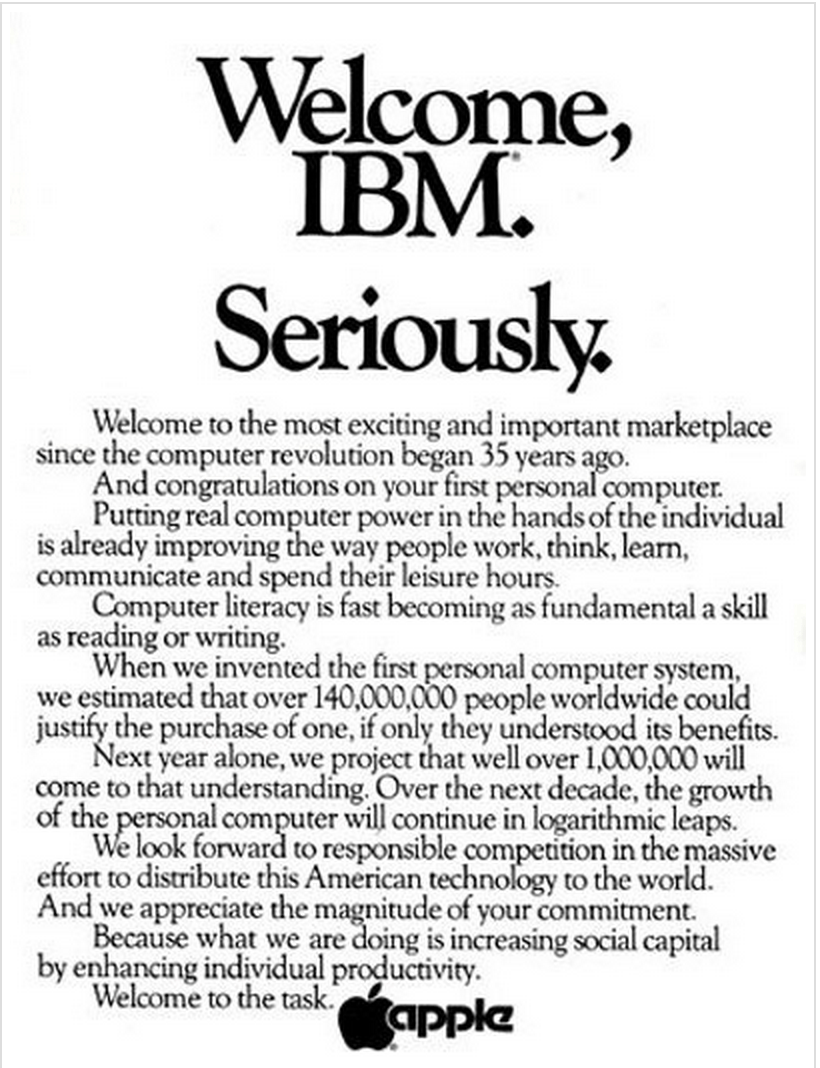 August 12, 1981: The launch of the IBM Personal Computer ignites a long-running Apple-versus-PC rivalry.
August 12, 1981: The launch of the IBM Personal Computer ignites a long-running Apple-versus-PC rivalry.
Secure in the Apple II’s technical superiority over the new PC, Apple welcomes International Business Machines to the personal computing party in a full-page ad in the pages of The Wall Street Journal. Things won’t stay positive for long.
The IBM Personal Computer launch
When it came to specs, the original IBM PC proved relatively pitiful. For $1,565, customers got an entry-level machine with 16K of memory, and an interface for a cassette tape player and monochrome monitor using a regular TV screen.
The more expensive, superior variation came with 64K of memory, two 5.25-inch floppy disk drives and a dedicated monochrome monitor. The total for that model climbed to $3,390 — the equivalent of $11,400 today. In other words, for the price of a decent IBM PC at launch, today you could kit out your office with a new iMac, MacBook, iPad, iPhone and Apple Watch.
IBM’s launch-day press release quoted C.B. Rogers Jr., IBM’s vice president and group executive of its General Business Group.
“This is the computer for just about everyone who has ever wanted a personal system at the office, on the university campus or at home,” Rogers said. “We believe its performance, reliability and ease of use make it the most advanced, affordable personal computer in the marketplace.”
To sell the PC (officially called it the IBM 5150, although barely anyone actually used the name), Big Blue took a note out of Apple’s playbook and focused on making the computer seem accessible and friendly. A series of comedic ads starring a Charlie Chaplin impersonator contrasted with IBM’s usual corporate approach to marketing.
IBM’s advantages over Apple
The IBM PC enjoyed two major advantages over the 4-year-old Apple II at the time.
The first was its brand name. Up until relatively recently, Apple struggled to gain traction with businesses that typically invested in IBM equipment. All of Apple’s 1980s attempts to make a business machine fell flat.
With Apple computers and IBM PCs unable to talk to one another until 1993 (when the companies shipped their first collaborative product), many customers who first used IBM computers at work simply decided to go with what they knew when buying their first home computers.
The IBM Personal Computer’s other advantage was the range of available software. Right out of the gate, the PC included versions of the hugely popular VisiCalc spreadsheet program and the EasyWriter word processor.
Both of these previously appeared on the Apple II. (EasyWriter was written by John Draper, who met Apple co-founders Steve Jobs and Steve Wozniak during their phone-phreaking days.) Other applications written specifically for the IBM PC — such as AutoCAD and Norton Utilities — soon followed.
Apple and IBM now work together

Photo: Apple
Today, Apple’s battle with IBM has cooled. The two companies even work together on various enterprise applications. For a whole generation, however, Apple versus IBM became the defining rivalry in tech. It later morphed into the Apple-versus-Microsoft battle, but that’s another story.
What’s your strongest memory from the Apple-versus-PC clash? When did you decide which side to join? Leave your comments and recollections below.


